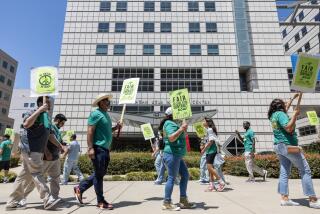UCIMC Falls Back in Red Due to Unmet Costs for Poor
- Share via
UCI Medical Center will report to the UC Board of Regents this week that it is plunging back into red ink because of a high percentage of poor patients whose care is not fully reimbursed by the state or the county.
The medical center’s annual report, to be released at a regents meeting Thursday and Friday at UC Davis, mentions no specific deficit figure. But in an interview Monday, UCI Vice Chancellor Leon Schwartz, who is director of the medical center, estimated that the hospital complex will lose $5 million by June 30, the end of the current fiscal year.
Schwartz said the situation will only worsen. He predicted up to a $9-million loss in the next fiscal year, which begins July 1.
Schwartz and other university officials have said UCI Medical Center suffers financially because 70% of its patients are in the “public pay” category. Public pay includes all patients not covered by privately paid hospital insurance.
Costs Rise, Payments Don’t
Schwartz said neither the state nor the county adequately reimburses the medical center for care of indigent patients. “Our costs go up with inflation, but the reimbursement from the state and the county stays pretty much the same each year,” Schwartz said.
UCI officials blamed the medical center’s worsening financial condition on its large load of indigent patients when it fell into debt in 1984 and 1985. The facility had deficits of $3 million in 1984 and $9.6 million in 1985.
In 1985, the Legislature appropriated special funds to bail out the medical center at UC Irvine, as well as those at UC Davis and UC San Diego.
In 1986 and 1987, UCI Medical Center swung back into the profit column. But as Schwartz had feared--and had publicly predicted last summer--the medical center during the current fiscal year again has begun showing a loss.
“It’s not as bad as I’d predicted last summer, however,” Schwartz said Monday. “Last summer I said there would likely be a $9-million deficit. Now we are estimating a $5-million deficit by the end of the fiscal year.”
The report to be presented to the regents says that “indigent program reimbursement has fallen significantly below inflation. The medical center is faced with absorbing the indigent program reimbursement at less than cost. . . . Projections for operations and reserves for the next two fiscal years indicate a return to significant operating losses and negative reserves.”
Schwartz said the medical center currently has the following breakdown of patients: 30% privately insured, 40% Medi-Cal, 15% Medicare and 15% whose care is paid for by the county because they are covered by neither Medi-Cal nor Medicare. Schwartz said Medicare payments are still adequate to pay for the costs of those patients. But he said Medi-Cal and county medical assistance fall considerably below actual costs.
‘Worst Payer . . . Is County’
“The worst payer, as far as reimbursing the cost of a patient, is the county,” Schwartz said. He noted that the state used to pay for the so-called “working poor”--those not covered by Medi-Cal or Medicare, but that in recent years that responsibility has been transferred to the counties.
“And when the state made the change, it only gave the counties 70% of the cost of medically caring for the indigent,” Schwartz said.
Orange County government, he said, thus has a financial problem in trying to pay for medical care for its indigents. And because UCI Medical Center has the bulk of those patients, it becomes the biggest fiscal loser, Schwartz said.
“UCIMC is not the only hospital taking in the county patients, but it has the largest percentage,” he added. “There are about 30 hospitals under contract to the county (for care of the poor), but ours has about 35% of the cases, by far more than any other.”
Schwartz said many of the poor patients specifically ask to be taken to UCI Medical Center.
“We have services they like, and we’re pleased that they like our hospital,” he said.
Nonetheless, he added, the university medical center would be better off if a lower percentage of the poor patients came there. He estimated that a 5% decrease in the number of poor patients and a corresponding increase in the percentage of privately insured patients could swing the medical center back into the black again.
More to Read
Sign up for Essential California
The most important California stories and recommendations in your inbox every morning.
You may occasionally receive promotional content from the Los Angeles Times.













